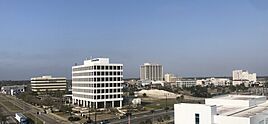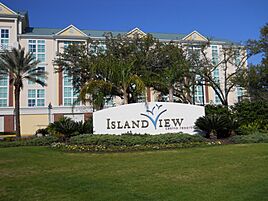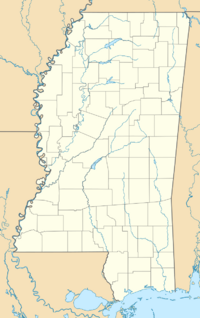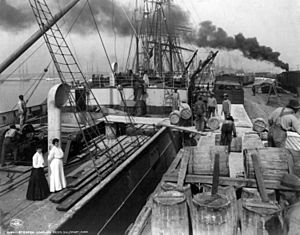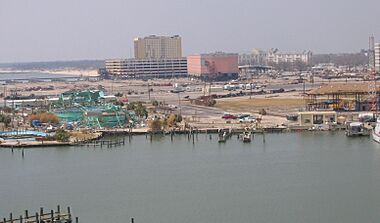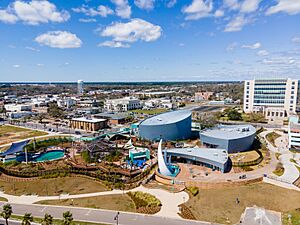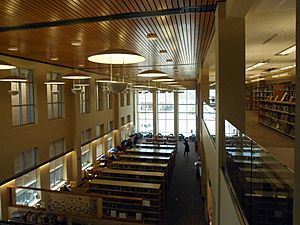Gulfport, Mississippi facts for kids
Quick facts for kids
Gulfport, Mississippi
|
|||||
|---|---|---|---|---|---|
|
Downtown Gulfport
Naval Construction Battalion Center
Great Southern Golf Club
Island View Casino
|
|||||
|
|||||
| Motto(s):
Anchored in Excellence
|
|||||

Location within Harrison County
|
|||||
| Country | United States | ||||
| State | Mississippi | ||||
| County | Harrison | ||||
| Incorporated | July 28, 1898 | ||||
| Government | |||||
| • Type | Strong mayor–council | ||||
| • Body | Gulfport City Council | ||||
| Area | |||||
| • City | 64.01 sq mi (165.79 km2) | ||||
| • Land | 55.62 sq mi (144.06 km2) | ||||
| • Water | 8.39 sq mi (21.73 km2) | ||||
| Elevation | 20 ft (6 m) | ||||
| Population
(2020)
|
|||||
| • City | 72,926 | ||||
| • Density | 1,311.08/sq mi (506.21/km2) | ||||
| • Urban | 236,344 (US: 169th) | ||||
| • Urban density | 1,401.5/sq mi (541.1/km2) | ||||
| • Metro | 416,259 (US: 133rd) | ||||
| Demonym(s) | Gulfporter | ||||
| Time zone | UTC−6 (CST) | ||||
| • Summer (DST) | UTC−5 (CDT) | ||||
| ZIP Codes |
39501-39503, 39505-39507
|
||||
| Area code(s) | 228 | ||||
| FIPS code | 28-29700 | ||||
| GNIS feature ID | 0670771 | ||||
Gulfport is a city in Harrison County, Mississippi, United States. It shares the role of being the main city for the county. In 2020, about 72,926 people lived there. This makes it the second-largest city in Mississippi, after Jackson. Gulfport is located along the Gulf Coast of the United States. It gets its name from its important port on the Mississippi Sound.
Gulfport started from two older towns, Mississippi City and Handsboro. It was founded in 1887 by William H. Hardy as a stop for the Gulf and Ship Island Railroad. Later, Joseph T. Jones, a rich businessman from Philadelphia, helped build the railroad, harbor, and channel. The city officially became a city in 1898.
In the early 1900s, Gulfport was the biggest city for exporting lumber in the U.S. This changed when most of Mississippi's pine forests were used up. The city then became a popular place for tourism. People came for its white beaches, large hotels, and casino games.
Today, Gulfport's main industries are military operations, tourism, healthcare, and shipping. It is home to the Naval Construction Battalion Center. The Port of Gulfport is one of the busiest ports in the Gulf of Mexico. The Gulfport-Biloxi International Airport serves the area. Gulfport has rebuilt and grown after being hit by strong hurricanes like Camille in 1969 and Katrina in 2005.
Contents
History of Gulfport
Before Gulfport was founded, two villages existed nearby: Mississippi City and Handsboro. Mississippi City was planned in 1837 as the end point for a railroad. This railroad was meant to move yellow pine wood for trade by ship. Even though the railroad project stopped for a while, the town was built. It later became the county seat for Harrison County in 1841.
The railroad company was restarted, and William H. Hardy became its president. He wanted to connect the railroad from Hattiesburg to the coast. He chose the site of Gulfport in 1887 because it was closer to deep water than Mississippi City. Hardy went bankrupt in 1893, and the town became almost empty. However, Joseph T. Jones, a wealthy oil businessman, bought the company. Jones paid for the railroad, much of the city, the harbor, and the digging of the channel. The city was named Gulfport in 1888. On July 28, 1898, Gulfport officially became a city. In 1902, Harrison County decided to move its main government office to Gulfport.
The railroad was finished in 1900, and the Port of Gulfport was completed in 1902. In 1904, Gulfport's port became the official entry point for trade in the area. It was easier to access than other ports like Mobile or New Orleans. The port quickly made Gulfport the biggest city in the U.S. for exporting lumber. In 1906, it shipped over 293 million feet of lumber. But as the yellow pine forests ran out, this industry declined in the early 1900s.
Around the turn of the century, Gulfport grew a lot. Its population reached 1,000 by 1900 and over 6,000 by 1910. Because of this growth, the city started a fire department and sanitation services. A county courthouse was built in 1903. The Louisville and Nashville train line also began serving the city. In 1910, the U.S. Post Office and Customhouse was built. In 1916, a Carnegie Library was planned. Other important buildings included the Great Southern Hotel, an electric plant, and a streetcar line.
In 1917, Gulfport was supposed to host a big event called the Mississippi Centennial Exposition. But when the U.S. entered World War I, the plans were stopped. The buildings made for the event were given to the U.S. Navy for training. These lands later became a Veterans Administration Hospital. The 1920s saw many new buildings, like the Hotel Markham and the Bank of Gulfport. By the 1930s, the population grew to over 12,000, and it kept growing into the 1940s.
During World War II, two military bases were built in Gulfport. Camp Hollyday, started in 1942, later became the Naval Construction Battalion Center. Also in 1942, the U.S. Army Air Corps built a training base for bomber crews called Gulfport Army Airfield. After the war, the city bought most of the airport facilities for a new Gulfport Municipal Airport. In 1954, the U.S. Air Force used some facilities again to train Air National Guard units. In 1958, these facilities were given to the Mississippi Air National Guard.

By 1950, Gulfport's population was about 22,000, and by 1960, it reached 30,000. In 1960, Gulfport had its own protest for civil rights, similar to the Biloxi wade-ins. In 1965, the city added the areas of Mississippi City and Handsboro. On August 17, 1969, Hurricane Camille hit Gulfport and the Mississippi Gulf Coast. It was one of the strongest hurricanes ever to hit the U.S. The waterfront areas of Gulfport were hit hardest. Storm waters reached 21 feet high, and the port was almost completely destroyed. Downtown and inland areas had less damage.
In 1976, the Armed Forces Retirement Home moved to Gulfport. This facility was destroyed by Hurricane Katrina in 2005. It was rebuilt as a much larger building in 2010. A new county courthouse was built in 1977. In 1993, Gulfport opened its first two casinos. Later that year, the city added about 33 square miles of land north of Gulfport. This new area included Turkey Creek, a historic community founded by freed slaves. In 2003, the Dan M. Russell Jr. United States Courthouse was finished.
On August 29, 2005, Hurricane Katrina hit Gulfport with strong winds and a storm surge of at least 19 feet. About 9,571 houses were damaged or destroyed. The city faced a $3 million debt. Gulfport received over $300 million in federal aid. This money was used to fix roads, buildings, and essential services. In 2020, on the 15th anniversary of Hurricane Katrina, the Mississippi Aquarium opened. It replaced a dolphin facility that the hurricane had destroyed.
Geography and Climate
Gulfport covers about 64 square miles (166 square kilometers). About 55.6 square miles (144 square kilometers) is land, and 8.39 square miles (21.73 square kilometers) is water.
Neighborhoods in Gulfport
In 2000, the city listed 39 official neighborhoods. These are often smaller communities or areas where homes have grown over time. Some of these neighborhoods include:
- Lyman
- Orange Grove
- Bayou View North
- Handsboro
- College Park
- Mississippi City
- East Beach
- Central Gulfport
- Turkey Creek
- CB Base
- North Gulfport
Weather in Gulfport
Gulfport has a humid subtropical climate. This means it has hot, humid summers and short, mild winters. The Gulf of Mexico helps keep the temperatures from getting too extreme. Cold weather does happen, but it usually does not last long. Snow is very rare in Gulfport.
Summers are long, hot, and humid. However, being close to the Gulf keeps summer highs from being as extreme as places further inland. Gulfport can experience severe weather, especially tropical storms and hurricanes from the Gulf of Mexico. The hottest temperature ever recorded in Gulfport was 107°F (42°C) on August 26, 2023. The coldest was 1°F (-17°C) on February 12, 1899.
People and Population
| Historical population | |||
|---|---|---|---|
| Census | Pop. | %± | |
| 1900 | 1,060 | — | |
| 1910 | 6,386 | 502.5% | |
| 1920 | 8,157 | 27.7% | |
| 1930 | 12,547 | 53.8% | |
| 1940 | 15,105 | 20.4% | |
| 1950 | 22,659 | 50.0% | |
| 1960 | 30,204 | 33.3% | |
| 1970 | 40,791 | 35.1% | |
| 1980 | 39,676 | −2.7% | |
| 1990 | 40,775 | 2.8% | |
| 2000 | 71,127 | 74.4% | |
| 2010 | 67,793 | −4.7% | |
| 2020 | 72,926 | 7.6% | |
| U.S. Decennial Census 2018 Estimate 2020 census |
|||
As of the 2020 United States census, Gulfport had 72,926 people. There were 25,559 households and 15,584 families living in the city. Gulfport is part of the larger Gulfport–Biloxi metropolitan area. This area has a population of 416,259 people.
Economy and Jobs
Gulfport started as a lumber port but has grown into a city with many different types of businesses. The city has about 6.7 miles (10.8 kilometers) of white sand beaches along the Gulf of Mexico. This has made Gulfport a popular place for tourists. The casinos along Mississippi's coast also bring many visitors.
Gulfport hosts popular events like "Cruisin' the Coast," which is a week for classic cars. "Smokin' the Sound" features speedboat races. Gulfport is a busy community with many homes and shops. It has historic neighborhoods and various shopping places. There are also several hotels for people who come for golfing, gambling, and water sports. The Island View Casino is one of twelve casinos on the Mississippi Gulf Coast.
The top employers in Gulfport include:
- Memorial Hospital
- Naval Construction Battalion Center
- Gulfport School District
- Harrison County School District
- Island View Casino
- Hancock Bank
- Mississippi Power
- Trent Lott Training
- Wal-Mart
- City of Gulfport
Arts and Culture
The Mississippi Aquarium opened on August 29, 2020. This 5.8-acre (2.3-hectare) complex has both indoor and outdoor areas. It is home to over 200 types of animals and 50 types of native plants.
Fort Massachusetts is a fort on West Ship Island along the coast. It was built after the War of 1812 and was used until 1903. Today, it is a historical place for tourists to visit within the Gulf Islands National Seashore.
The Turkey Creek Community Historic District is a community founded by freed African Americans. They settled there after the American Civil War.
City Government
Gulfport uses a strong mayor-council form of government. This means the mayor has a lot of power. The city is divided into seven areas called wards. People in each ward elect a member to the Gulfport City Council. The current mayor is Hugh Keating.
The Gulfport Police Department has 160 police officers and 80 civilian staff. The U.S. Coast Guard also helps. It operates 9 boats from the port of Gulfport. The Coast Guard station in Gulfport has 110 members. They respond to about 300 search and rescue calls each year.
The Gulfport Fire Department started in 1908. It puts out fires, handles dangerous materials, and performs technical rescues. The Fire Department has 11 stations and is staffed by professional firefighters. They work with American Medical Response for medical emergencies.
Education in Gulfport
The city of Gulfport is served by two school districts: the Gulfport School District and the Harrison County School District. The Harrison County Campus of Mississippi Gulf Coast Community College is also located in Gulfport.
Before Hurricane Katrina, William Carey University had a campus in Gulfport. In 2009, the university moved to its new Tradition Campus. This campus was built in north Harrison County.
The Gulf Park Campus of the University of Southern Mississippi is in Long Beach, just west of Gulfport. After Hurricane Katrina caused a lot of damage in 2005, repairs and renovations to the campus buildings continued for many years.
Media and News
The Sun Herald is the local newspaper for Gulfport, Biloxi, and other Gulf Coast cities. It won a Pulitzer Prize in 2006 for its coverage of Hurricane Katrina.
Gulfport has several FM and AM radio stations. It is also served by two television stations: WLOX (an ABC affiliate) and WLOX-DT2 (a CBS affiliate). WXXV is a Fox affiliate. WLOX won a Peabody Award for its Hurricane Katrina coverage.
Some movies and TV shows have been filmed in Gulfport. These include the 2016 film Precious Cargo and the 2017 TV movie Christmas in Mississippi. The 2015 TV series The Astronaut Wives Club was also filmed there.
Transportation
The Gulfport–Biloxi International Airport serves Gulfport, Biloxi, and the surrounding Gulf Coast area.
The Coast Transit Authority provides bus service in the region. They offer regular bus routes and special services for people with disabilities.
Major roads and highways serve Gulfport. Interstate 10 runs east to west through the middle of Gulfport. U.S. 90, which follows the coast, runs east to west through the downtown area. U.S. 49 comes from the north and ends in Gulfport.
Before Hurricane Katrina in 2005, Amtrak's Sunset Limited train stopped in Gulfport station. This train traveled from Los Angeles to Orlando. Train service returned on August 18, 2025, with the Mardi Gras Service. This service connects Gulfport to other cities along the Gulf Coast.
Notable People from Gulfport
Many interesting people have connections to Gulfport:
- Mahmoud Abdul-Rauf – A former professional basketball player in the NBA.
- Stacey Abrams – An American politician, lawyer, and author.
- Tommy Armstrong, Jr. – A college football quarterback.
- Jerome Barkum – A former professional football player for the New York Jets.
- Brett Favre – A famous quarterback in the National Football League, born in Gulfport.
- William H. Hardy – One of the co-founders of Gulfport.
- Josh Hayes – A professional motorcycle racer.
- Jaimoe – An original member and drummer of the Allman Brothers Band, who grew up in Gulfport.
- Joseph T. Jones – Another co-founder of Gulfport.
- Matt Lawton – A former Major League Baseball player.
- Brittney Reese – An Olympic gold medalist in the long jump.
- Stuart Roosa – An astronaut on Apollo 14.
- Natasha Trethewey – A Pulitzer Prize-winning poet and former Poet Laureate of the United States, born in Gulfport.
More About Gulfport
- Dan M. Russell Jr. United States Courthouse
- Great Southern Golf Club
- Gulf and Ship Island Railroad
- Mississippi Aquarium
- Turkey Creek Community Historic District
See also
 In Spanish: Gulfport (Misisipi) para niños
In Spanish: Gulfport (Misisipi) para niños


